The Good Times to Travel to Fiji!
Written by Real Travellers, Not Algorithms
As cliché as it might sound, there’s never really a “bad” time to visit Fiji. It all depends on how important the weather, crowds and the cost of travel is to you.
Fiji is a tropical country that experiences warm temperatures year-round. It only really experiences two distinct seasons: the dry season (winter) and the wet season (summer), which brings with them a set of conditions that makes certain activities, like surfing and manta ray swimming, better to do.
There are also, of course, certain events and festivals that only occur at particular times of the year that you might want to coincide your trip with. We go through all of these factors and more in this guide to the best time to visit Fiji!
Just a side note: All our travel tips come from genuine experiences in Fiji, shared by our team of seasoned travel writers (not AI-generated content). Scroll down to learn more about who we are and our expertise in Fijian travel.
Table of Contents
The Best Months to Visit Fiji: May, October and November
For those who have the privilege of choosing any month to travel, the shoulder season months are the best months to visit Fiji (see the “When is the High and Low Season in Fiji?” section below).
To narrow it down further, in our experience, May, October and November are the best months to visit Fiji as they have warm temperatures leading into (or out of) the wet season yet less rainfall than the wet season. May and October are also when you can do seasonal activities, such as surfing and swimming with manta rays.

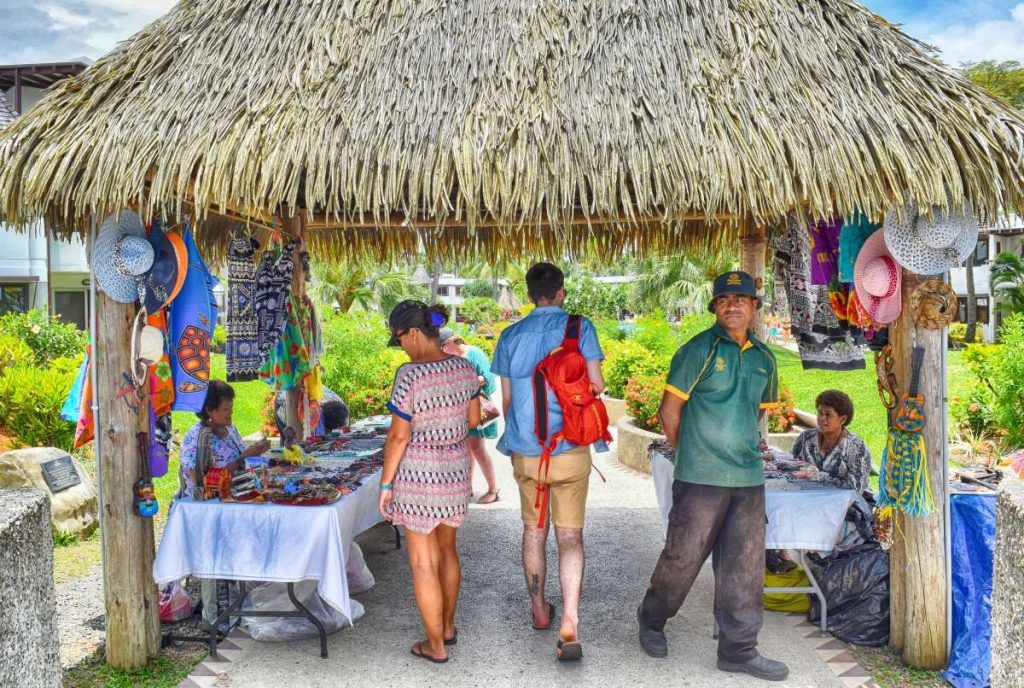 © FijiPocketGuide.com
© FijiPocketGuide.comWhen is the High and Low Season in Fiji?
I.e. When is the Peak, Shoulder and Off-Season in Fiji?
In terms of the tourist seasons, Fiji experiences three: a high season, a low season and shoulder seasons in between.
High Season (June – September and December): The Time with the Best Weather
The high season falls during the southern hemisphere’s winter season. This is when the New Zealand and Australia school holidays are, coinciding with it being the coldest months in these two countries where most travellers to Fiji are visiting from.
Being in the middle of the dry season, it’s also a favourable time for travellers wanting to avoid the rain as much as possible while temperatures are warm. December is also included in the high season months, as there is a lot of travel to the country during the Christmas period for locals and visitors alike.
Low Season (January – April): The Time with Fewer Tourists
After the Christmas holidays, the tourism industry in Fiji is at its quietest in terms of tourist numbers. Although temperatures are at their highest, the higher likelihood of rain puts some travellers off.
January to April, however, is a slightly more popular time for travellers from the northern hemisphere escaping their winter.
Check out more benefits of visiting in the least-popular season in the 10 Reasons to Travel in the Low Season in Fiji.
Shoulder Seasons (May, October & November): The Best of Both Worlds
The shoulder seasons are all the months between the low and high seasons. These months tend to experience the best of both seasons: weather that’s warm but not too humid nor too cold, less rain than in the wet season yet fewer tourists than in the high season, etc. In our opinion, the shoulder seasons are the best time to travel to Fiji.
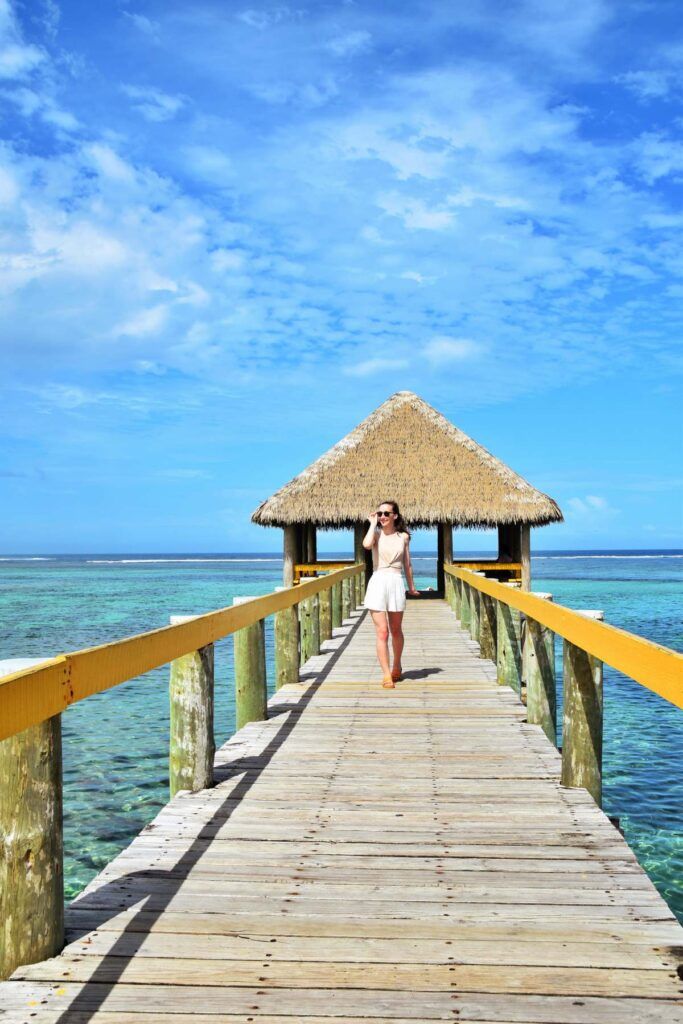 © FijiPocketGuide.com
© FijiPocketGuide.comMore About the Best Time to Visit Fiji for the Weather
Weather plays a huge role in many of our minds when determining the best time to visit Fiji. There are two seasons you need to be aware of: the dry/winter season (May to October) and the wet/summer season (November to April).
Skip the next bit and just check out Fiji Weather, Seasons & Climate + Weather by Month to get a full rundown of the weather. Otherwise, here’s a quick overview of Fiji’s weather month by month.
Fiji Weather in the Dry Season (Winter)
Months: May, June, July, August, September and October
Tourist Season: High season
Temperature: 19-29°C (66-84°F)
Rainfall/month: 70-150 mm (2.8-6 in)
About the Dry Season in Fiji
The dry season is the most appealing time for most holidaymakers to come to Fiji due to this season typically having the least amount of rainfall and the most comfortable temperatures coinciding with cold winters in the nearby countries of Australia and New Zealand. That’s not to say that it doesn’t rain at all, so it’s best to set expectations right to avoid disappointment. We’ve been caught many times in the rain during the dry season, sometimes for several consecutive days.
Because it is the most popular time to visit Fiji, airfares and resort rates tend to be at their highest, especially from June to August. Later in the season, we’ve noticed fares decreasing and the tourist numbers dwindling.
We’ve also noticed that this is also the season, particularly in the Yasawa Islands, that attracts mostly backpackers. This period offers sunny weather and calm seas in the Yasawas, making it ideal for younger, budget-conscious travellers seeking adventure and social experiences.
The Best Places to Visit in the Dry Season
There’s not really a “bad” place to visit in the dry season in Fiji. Nevertheless, here are a few suggestions for the best places to visit during the dry season…
For more great places to visit, check out The Best Islands to Visit in Fiji.
| 🌤️ Month | 🌡️ Temperature | 🌊 Sea Temperature | 🌧️ Rainfall | 🌟 Why Visit |
|---|---|---|---|---|
| May | 28°C / 82°F day, 21°C / 70°F night | 27°C / 81°F | 142 mm / 5.6 in |
|
| June | 27°C / 81°F day, 20°C / 68°F night | 27°C / 81°F | 113 mm / 4.4 in |
|
| July | 26°C / 78°F day, 20°C / 68°F night | 26°C / 79°F | 86 mm / 3.4 in |
|
| August | 26°C / 78°F day, 19°C / 66°F night | 25°C / 77°F | 103 mm / 4.1 in |
|
| September | 27°C / 81°F day, 20°C / 68°F night | 25°C / 77°F | 123 mm / 4.8 in |
|
| October | 27°C / 81°F day, 21°C / 69°F night | 26°C / 79°F | 152 mm / 6 in |
|
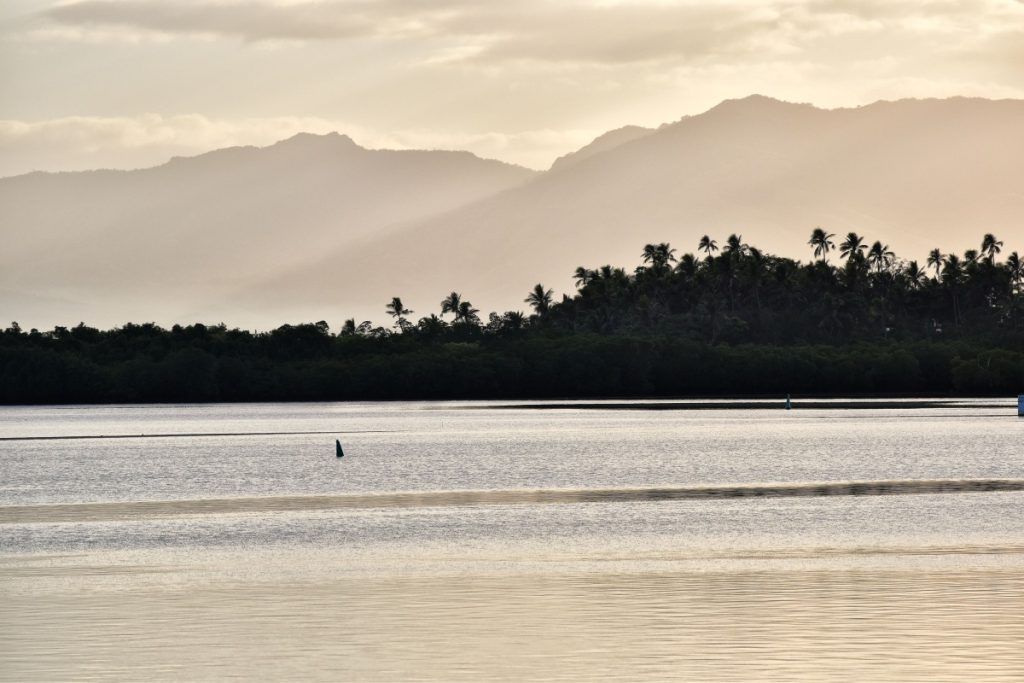 © FijiPocketGuide.com
© FijiPocketGuide.comFiji Weather in the Wet Season / Rainy Season (Summer)
Months: November, December, January, February, March and April
Tourist Season: Low season (except Christmas & New Year)
Temperature: 22-33°C (72-91°F)
Rainfall/month: 180-310 mm (2.8-6 in)
About the Wet Season in Fiji
The “Wet Season” or the “Rainy Season” can’t help but conjure up damp and dreary images ruining your holiday in paradise, but it sounds worse than it actually is. Sure, Fiji’s summer season is the wettest and most humid time of the year to visit Fiji, but rainfall patterns tend to be short, heavy and soon change back to sunshine.
We’ve enjoyed many trips to Fiji during the wet season (and honestly, we’ve often preferred it to the dry season).
Because of this higher rainfall rate than in winter, the wet season is the quietest time to visit Fiji, resulting in fewer crowds, lower airfares and resort rates. That’s all with the exception of the December holiday season, when things get more expensive and busy around Christmas and New Year.
This season sees a shift in clientele, particularly in the Yasawa Islands, with the islands appealing more to an older crowd. These visitors may prefer the quieter atmosphere, lower prices, and less crowded conditions that the off-season provides.
The Best Places to Visit in the Wet Season
If you’re looking for the driest climates in Fiji, these are the island groups and regions of Viti Levu to consider travelling to.
- Mamanuca Islands
- Yasawa Islands
- Nadi, Viti Levu
- Denarau, Viti Levu
- The Suncoast, Viti Levu
For more great places to visit, check out The Best Islands to Visit in Fiji.
| 🌤️ Month | 🌡️ Temperature | 🌊 Sea Temperature | 🌧️ Rainfall | 🌟 Why Visit |
|---|---|---|---|---|
| November | 29°C / 84°F day, 21°C / 69°F night | 27°C / 81°F | 181 mm / 7.1 in |
|
| December | 29°C / 84°F day, 22°C / 72°F night | 28°C / 82°F | 226 mm / 8.9 in |
|
| January | 30°C / 86°F day, 23°C / 73°F night | 28°C / 82°F | 308 mm / 12.1 in |
|
| February | 33°C / 91°F day, 21°C / 70°F night | 29°C / 84°F | 293 mm / 11.5 in |
|
| March | 31°C / 89°F day, 23°C / 73°F night | 29°C / 84°F | 356 mm / 14 in |
|
| April | 31°C / 89°F day, 20°C / 68°F night | 28°C / 82°F | 288 mm / 11.3 in |
|
Again, head to our Fiji Weather, Seasons & Climate + Weather by Month for a complete weather and climate rundown.
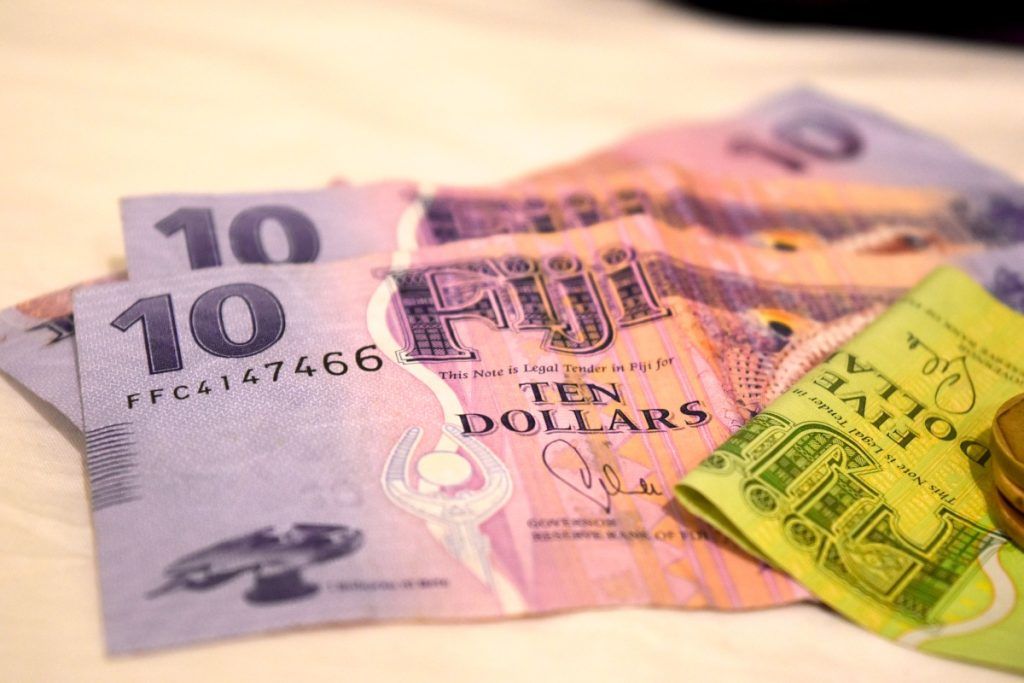 © FijiPocketGuide.com
© FijiPocketGuide.comThe Cheapest Time to Visit Fiji
If you’re on a bit of a budget, travelling in the right season can help reduce some costs.
The Best Time to Visit Fiji for Cheap Accommodation
The biggest saving you can make is on the nightly rate of accommodation if you stay during the shoulder or low season – usually anywhere between November and March.
Not only have we seen prices change across the months on platforms like Booking.com and Expedia, but many accommodations offer special low-season deals on their websites. We’ve also seen the difference between low and high season rates as much as FJ$500 per night!
Plus, low-season deals such as “stay five nights, pay for four” are common in the low season.
The Best Time to Fly to Fiji
The best time to fly to Fiji for cheaper flights is late-January to May if coming from the southern hemisphere – typically for the direct flights we list in Which Airlines Fly Directly to Fiji? If coming from the northern hemisphere, you’re more likely to find cheaper airfares to Fiji between September to November or March to May.
All of this is explained in more detail in How to Book a Cheap Flight to Fiji.
 © FijiPocketGuide.com
© FijiPocketGuide.comThe Best Time to Visit Fiji for Seasonal Activities
If you’re visiting Fiji with the intention of doing a particular activity, then be sure to research the best seasons to do your chosen activity. Scuba diving, surfing, fishing and wildlife activities all have “seasonal” elements.
The Best Time for Scuba Diving in Fiji
In terms of visibility, the winter season, a.k.a. The “dry season”, is considered the best time for scuba diving in Fiji, and this certainly has been the case on our regular trips to Fiji.
June to November experiences much less precipitation than the rest of the year, which can improve visibility. Visibility in the winter season can be 30-50 m (98-165 ft).
See how this compares to scuba diving in summer in When is the Best Time to Dive in Fiji?
The Best Time to Surf in Fiji
There’s never really a bad time to surf in Fiji, but there are better months for different skill levels. In short, the best months to surf in Fiji are for:
- Beginners – November to May
- Intermediates – March to April and September to October
- Experts – May to August.
Be sure to check out our guide, The Best Time to Surf in Fiji, for much more tips.
The Best Time to See Wildlife in Fiji
One of the most popular seasonal wildlife activities is swimming with manta rays, which can only be done between May and October. If you’re visiting Fiji to see other wildlife, then the wildlife seasons are as follows:
- Manta ray season: May to October
- Whale season: June to October
- Turtle season: All year round
- Bird season: All year round
- Shark season: All year round
- Dolphin season: All year round.
For more details, head over to The Best Seasons for Seeing Wildlife in Fiji.
The Best Time for Fishing in Fiji
Fishing can be enjoyed all year round in Fiji, but particular game species have better seasons than others. Aim for the following months for your targeted species:
- Blue Marlin: November to January
- Black Marlin: November and December
- Sailfish: June to September
- Yellowfin Tuna: November to March
- Dogtooth Tuna: October to March
- Skipjack: January to February and August to October
- Mahimahi: October to January
- Spanish Mackerel: October to December
- Wahoo: June to September
- Giant Trevally: June to September.
Again, we have much more advice that you won’t want to miss in What is the Best Time of Year for Fishing in Fiji.
 © FijiPocketGuide.com
© FijiPocketGuide.comIn Conclusion: 4 Things to Consider for Choosing a Time to Visit Fiji
As you can see, the best time to visit Fiji is different for everyone. In conclusion, choose the right season that appeals to you based on the four main aspects to consider when choosing the best season to travel Fiji:
1. The Weather
Let’s not beat around the bush. You’re not planning a tropical getaway to be cold and miserable. Luckily, Fiji is warm all year round, but there are seasons with higher rainfall and humidity that you might want to think about before you book your flight.
2. The Crowds
Fiji is a country that never really feels too “crowded”, with the exception of the largest resorts in the high season… So if you want to really escape from it all, consider choosing a less busy tourist season to visit Fiji. Alternatively, there are plenty of remote boutique island resorts which always feel quiet.
3. The Cost
The resorts, airlines and even some activity providers know when most tourists want to visit Fiji, and they are not afraid to take advantage of this with their prices. If you’re on a budget, you might want to consider visiting Fiji in its low season.
4. The Activities
While most activities can be done year-round, there are times of the year that are better for certain activities than others. Plus, there are a few seasonal activities too, such as swimming with manta rays, which is only available between May and October. There are also distinct seasons for fishing and for surfing.
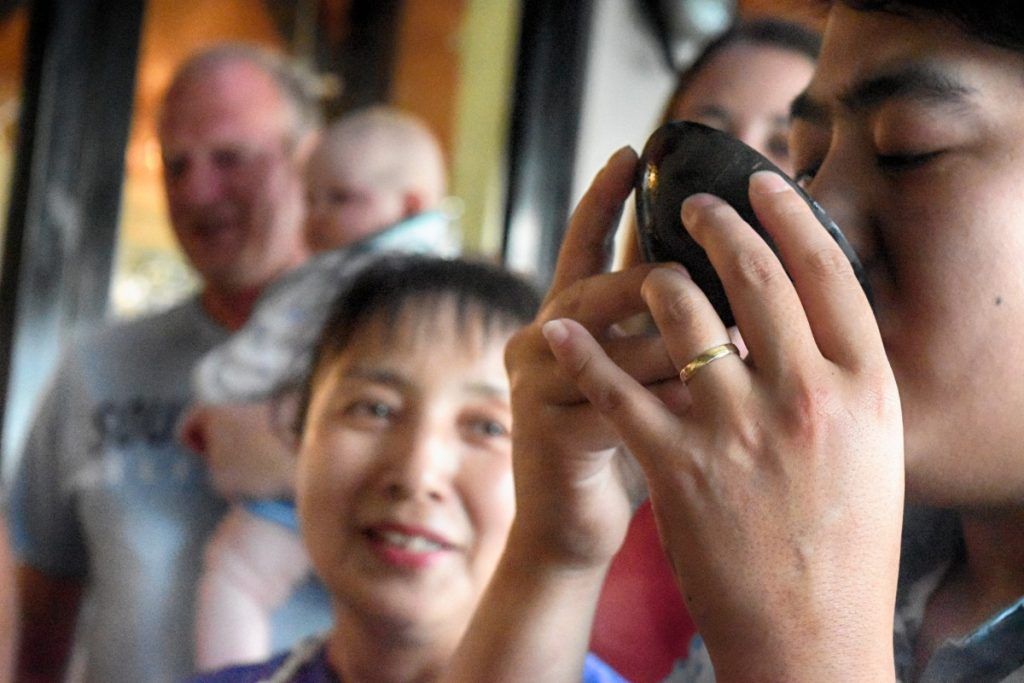 © FijiPocketGuide.com
© FijiPocketGuide.comFrequently Asked Questions About the Best Time to Visit Fiji
Still haven’t had your question about the best time to visit Fiji answered yet? Perhaps these frequently asked questions about the best time to visit Fiji will help!
What is considered the best time to visit Fiji?
In general, the best time to visit Fiji is during its dry season, from May to October. During these months, the weather is cooler, less humid, and there is less rainfall, making it ideal for outdoor activities and exploring the islands. This period also offers the clearest waters for snorkelling and diving.
But for our personal opinion for the best time to visit Fiji, we consider the fringes of the dry season, May and October, to be the best months to visit Fiji to enjoy the benefits of the weather while avoiding the crowds.
When is the worst time to visit Fiji?
The worst time to visit Fiji is generally during the wet season, which runs from November to April. This period experiences higher rainfall, increased humidity, and a greater risk of tropical cyclones.
However, it’s worth noting that this season also offers lower prices and fewer crowds! We actually sometimes prefer it to the dry season!
Are there any advantages to visiting Fiji during the wet season?
Visiting Fiji during the wet season (November to April) can have its advantages, such as fewer tourists, lower prices and more vibrant landscapes thanks to the frequent rain showers.
While there’s a higher chance of rain and it’s the cyclone season, there are still many sunny days, and the water temperatures remain warm for swimming and water sports.
How does the peak tourist season affect travel to Fiji?
The peak tourist season in Fiji, which coincides with the dry season from May to October, sees the highest number of visitors. This can lead to higher prices for flights, accommodations and activities.
However, it also means more events and festivals, making it a lively time to experience the local culture. Booking in advance is recommended to secure the best deals and availability.
What is the off-peak season in Fiji, and why might it appeal to some travellers?
The off-peak season in Fiji is during the wet season, from November to April. This season appeals to travellers looking for lower prices and fewer crowds.
It’s an excellent time for those interested in experiencing the lushness of Fiji’s natural environment at its peak, as well as for travellers willing to be flexible with their plans due to the unpredictable weather.
Can I enjoy water activities in Fiji outside of the dry season?
Yes, water activities can be enjoyed in Fiji year-round. Even during the wet season, the sea temperatures are warm, and there are many sunny days between the rain showers, allowing for swimming, snorkelling and diving.
However, it’s always important to check local weather conditions and heed safety advice, especially during the cyclone season.
What months offer the best balance between good weather and avoiding crowds?
The shoulder months of the dry season, such as May and October, offer a good balance between enjoying the favourable weather conditions and avoiding the peak tourist crowds. These months provide pleasant weather, less crowded attractions, and often better deals on accommodations and activities.
Are there any specific times to avoid travelling to Fiji?
If you prefer to avoid the risk of cyclones and the heaviest rainfall, it might be best to avoid the late wet season months of February and March.
Additionally, if you’re looking to steer clear of higher prices and more significant crowds, consider skipping the peak months of July and August, which coincide with Australian and New Zealand school holidays.
What is the best month to go to Fiji?
November is the best month to go to Fiji by having warm and dry weather yet fewer tourists. There also tends to be good travel deals during this month.
What is the hottest month in Fiji?
The hottest months in Fiji are typically January or February.
How bad is the wet season in Fiji?
Some years have been worse than others, with some wet seasons bringing cyclones. Find out more in How to Prepare for a Cyclone in Fiji.
Does Fiji have a hurricane season?
Yes, the hurricane season is otherwise known as the cyclone season, which runs from November to April. However, the greatest risk of cyclones occurring is in December, January and February.

More About the Best Time to Visit Fiji
That’s it for our guide to the best time to visit Fiji but by no means the end of our advice! Check out the following guides for more tips concerning the best time to visit Fiji and when to travel:
- What is the Weather Like in Fiji?
- Public Holidays in Fiji (& Other Important Dates)
- Do You Need a Visa to Visit Fiji?
For the best durations of time to visit Fiji, take a look at our compilation of itineraries: The Best Fiji Itineraries for 2 Weeks, The Best Fiji Itineraries for 1 Week, The Best Fiji Itineraries for 5 Days and The Best Fiji Itineraries for a Weekend.
Sources:
The information in this guide has been compiled from our extensive research, travel and experiences across Fiji and the South Pacific, accumulated over more than a decade of numerous visits to each destination. Additional sources for this guide include the following:
- Tourism Fiji (General travel advice - Updated [2025])
- Fiji Immigration (Visa and immigration advice - Updated [2025])
- Fiji Revenue & Customs Service (Customs and visitor taxes - Updated [2025])
- Biosecurity Authority of Fiji (Biosecurity advice - Updated [2025])
- Fiji Meteorological Service (Weather forecast and warnings - Updated [2025])
- Fiji Bureau of Statistics (Statistics and travel data - Updated [2025])
- Ministry of Tourism and Civil Aviation (Tourism statistics - Updated [2025])
- Land Transport Authority (Road safety advice - Updated [2025])
- Safe Travel (New Zealand travel advisory for Fiji - Updated [2025])
- Smart Traveller (Australia travel advisory for Fiji - Updated [2025])
- Travel.State.Gov (U.S. travel advisory for Fiji - Updated [2025])
- SPTO (Pacific tourism advice - Updated [2025])
- Fiji Hotel and Tourism Association (Tourism trade association - Updated [2025])
Our editorial standards: At Fiji Pocket Guide, we uphold strict editorial standards to ensure accurate and quality content.

About The Author
Robin (Ruveni) C.
This article was reviewed and published by Robin, the co-founder of Fiji Pocket Guide. He has lived, worked and travelled across 16 different countries before settling in the South Pacific, so he knows a thing or two about planning the perfect trip in this corner of the world. Robin is also the co-founder of several other South Pacific travel guides and is a regular host of webinars with the South Pacific Tourism Organisation.
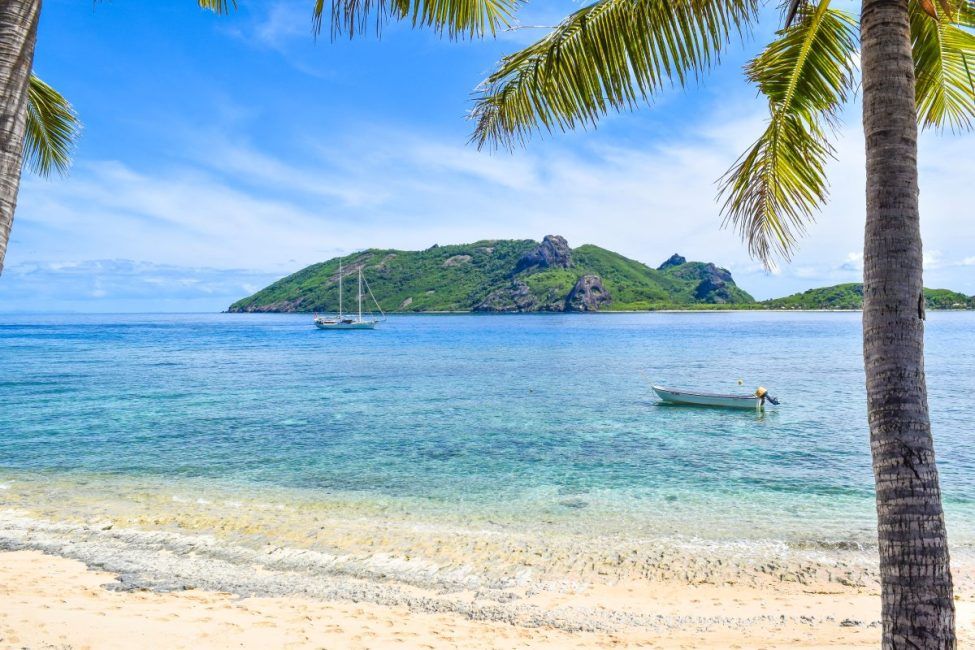
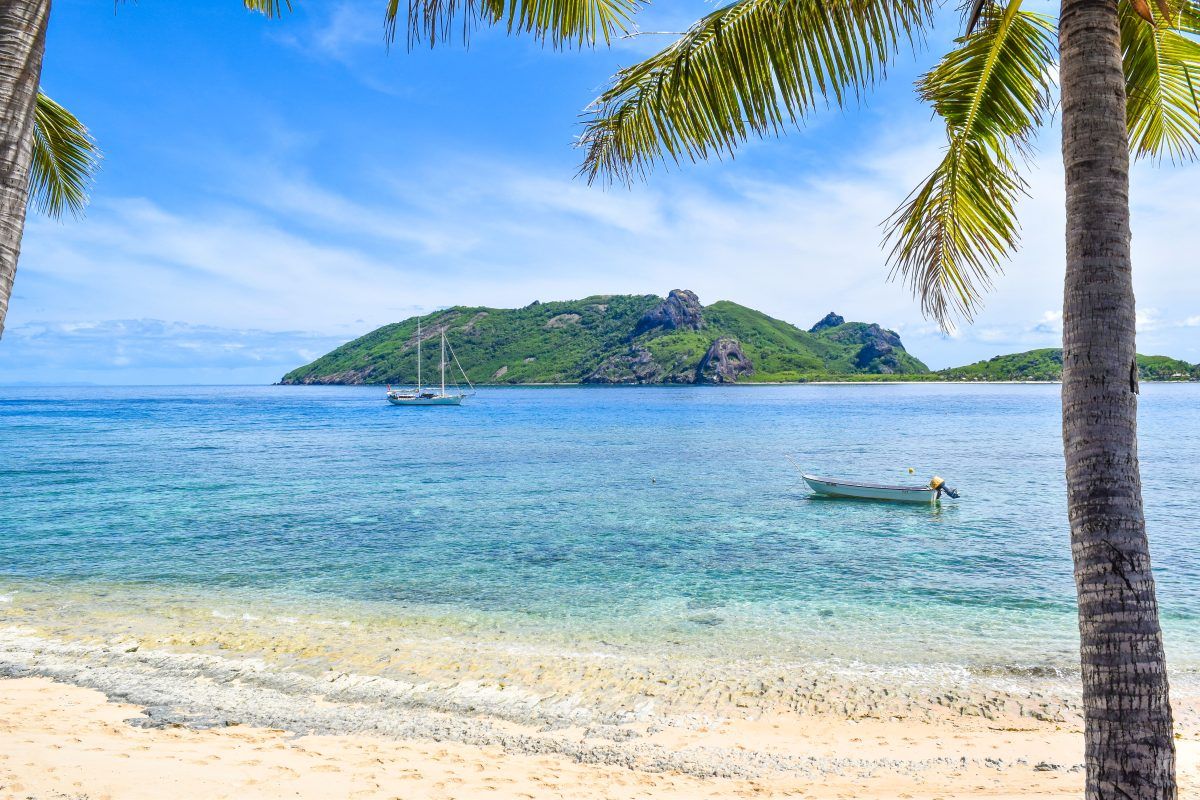


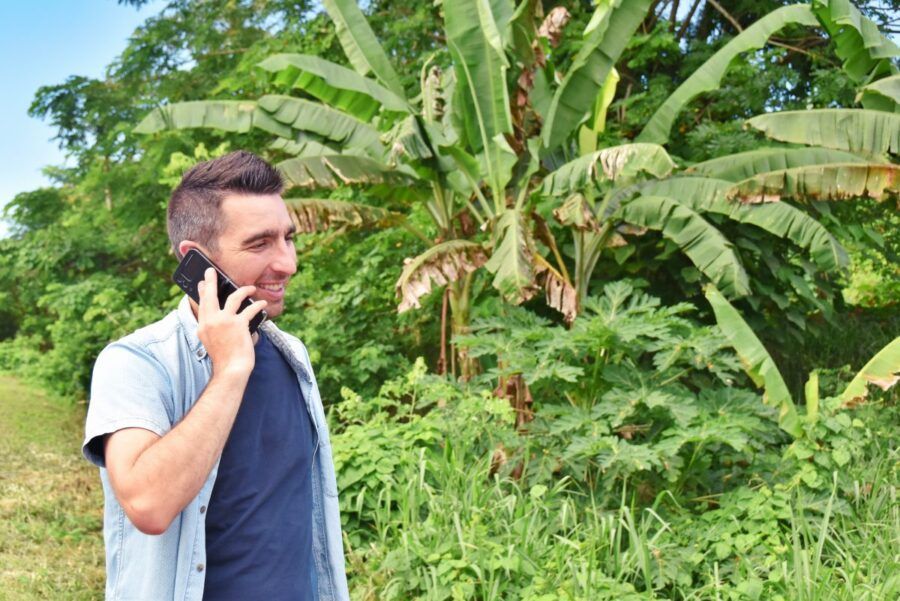
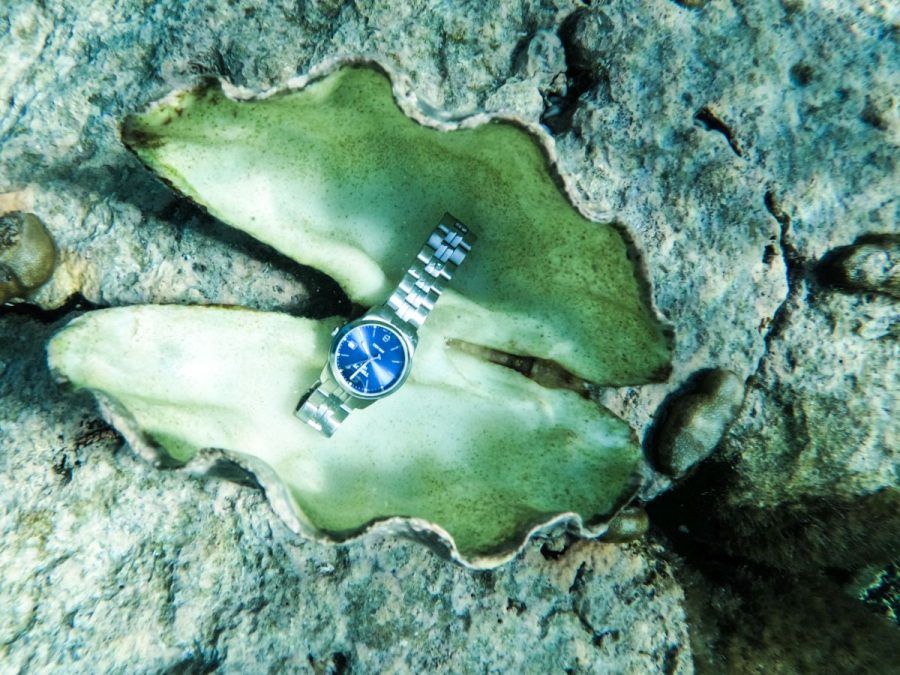
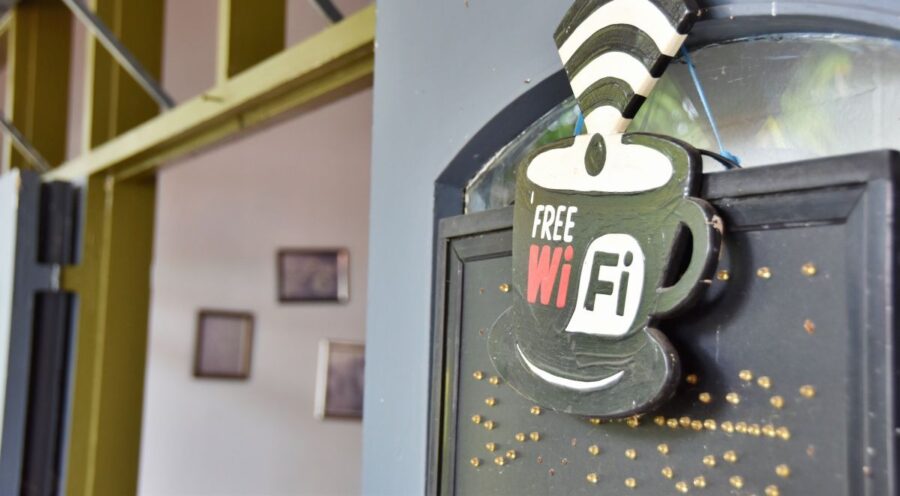
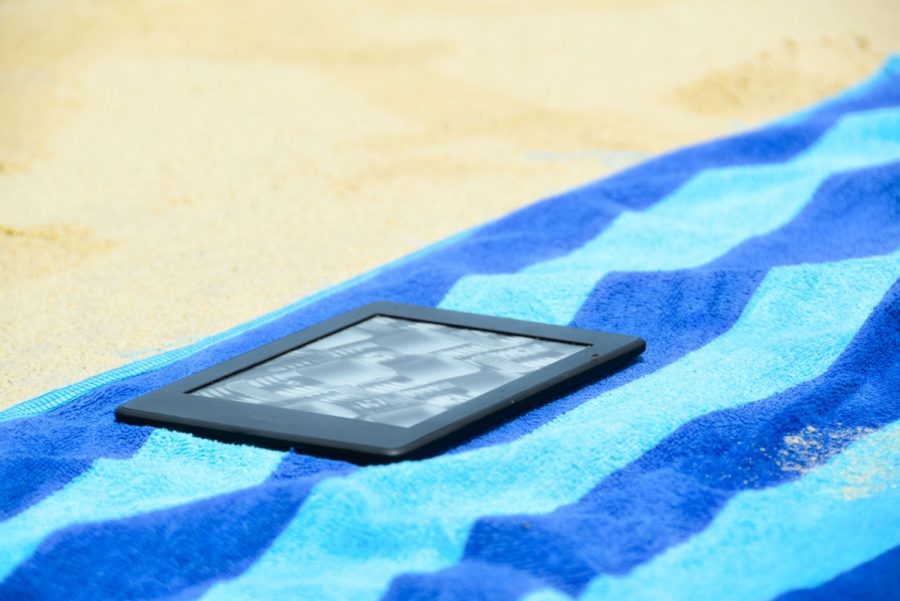

![How to Get Internet & WiFi in Fiji 🌐 [2025]](https://fijipocketguide.com/wp-content/uploads/2024/09/Digicel-Airport-Phone-CREDIT-Fiji-Pocket-Guide--900x601.jpg)

![Fiji Packing List: What to Pack for Fiji ???? [2025]](https://fijipocketguide.com/wp-content/uploads/2024/01/Packing-Bikini-Swimwear-Clothes-MUST-CREDIT-LINK-CookIslandsPocketGuide.com_-900x601.jpg)